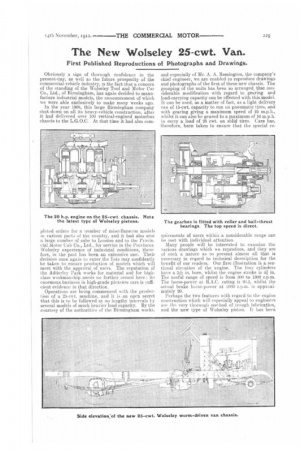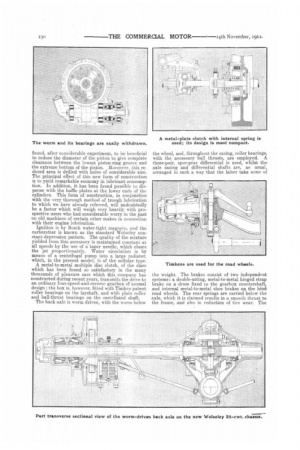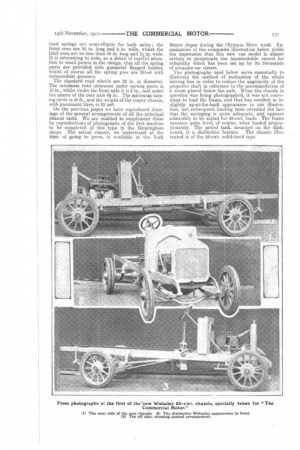The New Wolseley 25-cwt. Van.
Page 9

Page 10

Page 11

If you've noticed an error in this article please click here to report it so we can fix it.
First Published Reproductions of Photographs and Drawings.
Obviously a sign of thorough confidence in the present-day, as well as the future prosperity of the commercial-vehicle industry, is the fact that a concern of the standing of the Wolseley Tool and Motor Car Co., Ltd., of Birmingham, has again decided to manufacture industrial models, the announcement of which we were able exclusively to make many weeks ago,
In the year MS, this large Birmingham company shut down on all its heavy-vehicle construction, after it had delivered over 100 vertical-engined motorbus chassis to the L.G.O.C. At that time it had also corn pleted orders for a number of miscellaneous models in various parts of the country, and it had also sent a large number of cabs to London and to the Provineial Motor Cab Co., Ltd., for service in the Provinces. Wolseley experience of industrial conditions, there. fore, in the past has been, an extensive one. Their decision once again to enter the lists may confidently be taken to ensure production of models which will meet with the approval of users. The reputation of the Adderley Park works for material and for highclass workmanship needs no further record here ; its enormous business in high-grade pleasure cars is suffi• eient evidence ia that direction.
Operations are being commenced with the production of a 25-cwt. machine, and it is an open secret that this is to be followed at no lengthy intervals by several models of much heavier load capacity. By the courtesy of Hie authorities of the Birmingham works,
and especially of Mr. A. A. Remington, the company's chief engineer, we are enabled to reproduce drawings and photographs of the first of these new chassis. The grouping of the units has been so arranged. that considerable modification with regard togearing and load-carrying capacity can be effected with this model. It can be used, as a matter of fact, as a light delivery van of 15-cwt. capacity to run on pneumatic tires, and with gearing giving a maximum speed of 25 m.p.h., whilst it can also be geared to a maximum of 16 M.p.h. to carry a load of 25 cwt. on solid tires. Care has, therefore, been taken to ensure that the special re
quirements of users within a considerable range can be met with individual attention.
Many people will be interested to examine the various drawings which we reproduce, and they are of such a nature as to present almost all that is necessary in regard to technical description for the benefit of our readers. Our first illustration is a sectional elevation of the engine. The lour cylinders have a 3-h in. bore, whilst the engine stroke is 4 in. The useful range of speed is from 300 to 1600 r.pan. The horse-power at B.A.C. rating is 20.3, whilst the actual brake horse-peer at 1000 r.e.m. is approximately 20_
Perhaps the two features with regard to the engine construction which will especially appeal to engineers are the very thorough method of trough lubrication, and the new type of Wolseley piston. It has been
found, after considerable experiment, to be beneficial to reduce the diameter of the piston to give complete clearance between the lowest piston-ring groove and the extreme bottom of the piston. Moreover, this reduced area is drilled with holes of considerable size. The principal effect of this new form of construction is to yield remarkable economy in lubricant consumption. In addition, it has been found possible to dispense with the baffle plates at the lower ends of the cylinders. This form of construction, in conjunction with the very thorough method of trough lubrication to which we have already referred, will undoubtedly be a factor which will weigh very heavily with prospective users who had considerable worry in the past on old machines of certain other makes in connection with their engine lubrication.
Ignition is by Bosch water-tight magneto, and the carburetter is known as the standard Wolseley constant-depression pattern. The quality of the mixture yielded from this accessory is maintained constant at all speeds by the use of a taper needle, which closes the jet proportionately. Water circulation is by means of a centrifugal pump into a large radiator, which, in the present model, is of the cellular type. A metal-to-metal multiple disc clutch, of the class which has been found so satisfactory in the many thousands of pleasure cars which this company has constructed during recent years, transmits the drive to an ordinary four-speed-and-reverse gearbox of normal design ; the box is, however, fitted with Timken patent roller bearings on the layshaft, and with plain roller and ball-thrust bearings on the castellated shaft. The back axle is worm driven, with the worm below
the wheel, and, throughout the casing, roller bearings, with the necessary ball thrusts, are employed. A three-pair, spur-gear differential is used, whilst the axle casing and differential shafts are, as usual, arranged in such a way that the latter take none of the weight. The brakes consist of two independent systems: a double-acting, metal-to-metal hinged strap brake on a drum fixed to the gearbox countershaft, and internal metal-to-metal shoe brakes on the hind road wheels. The rear springs are carried below the axle, which it is claimed results in a smooth thrust to the frame, and also in reduction of tire wear. The road springs are semi-elliptic, for both axles ; the front ones are 36 in. long and 2 in. wide, whilst the hind ones are no less than 50 in. long and VA in. wide. it is interesting to note, as a detail of careful attention. to small points in the design, that all the spring parts are provided with gunmetal flanged bushes, whilst of course all the spring pins are fitted with independent greasers.
The standard road wheels are 32 in. in diameter. The minimum road clearance under sprung parts is 10 in., whilst under the front axle it is 9 in., and under the centre of the rear axle 6iin. The minimum turning circle is 40 ft., and the weight of the empty chassis, with pneumatic tires, is 23 cwt.
On the previous pages we have reproduced drawings of the general arrangements of all the principal chassis units. We are enabled to supplement these by reproductions of photographs of the first machine to be completed of this type in the Birmingham shops. The actual chassis, we understand at the time of going to press, is available at the York Street depot during the Olympia. Show week. Exaraination of the composite illustration below yields the impression that this new van model is almost certain to perpetuate the incontestable record for reliability which has been set up by its thousanda of pleasure-car sisters. The photographs used below serve essentially to' illustrate the method of inclin.ation of the whole driving line in order to reduce the angularity of the propeller shaft in reference to the accommodation of a. worm placed below the axle. When the chassis in question was being photographed, it was not convenient to load the frame, and that has resulted in its slightly up-at-the-back appearance in our illustration, but subsequent loading tests revealed the factthat the springing is quite adequate, and appears admirably to be suited for 25-cwt. loads, The frame becomes quite level, of course, when loaded proportionately. The petrol tank, mounted on the dash
board, is a distinctive feature. The chassis illustrated is of the 25-cwt. solid-tired type.
























